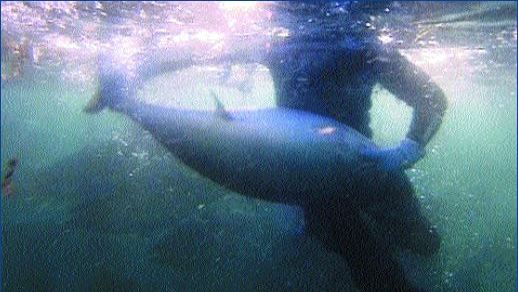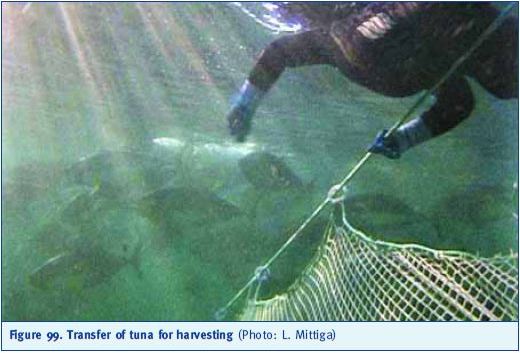Harvesting systems
The products from the capture-based aquaculture of tuna are nearly all destined for the Japanese market, where they will be used mostly for “sushi” and “sashimi”. To achieve the best prices in this specialist market, producers must harvest high quality tuna; this requires special care in the killing and handling of the fish during harvesting.
The criteria used to define high quality tuna are:
? a high level of freshness;
? signs of a fast bleeding of tuna after the kill;
? the absence of flesh burns due to lactic acid formation;
? the absence of, or a very low level of histamine; and
? a high fat content.
It is evident that harvest practices influence such quality attributes as freshness, fat content, colour and shape.
When bluefin reach the optimum weight and fat content, and when the market price is favourable, harvesting begins. In the Mediterranean area the fish are ready for harvesting by October. Some farms market all their fish by December; others linger on till February/March, depending on transport logistics. For instance, if air transport is a problem, the fish may have to be sold in frozen form rather than fresh (Agius 2002). Generally the processing volume targeting the frozen fish market depends on the daily blast freezing capacity of the ships. Once freezing is complete, the ships transfer the fish to a reefer ship which then goes to the Far East (Agius 2002).
In harvesting, bluefin tuna are typically crowded into a small area using a net, where divers capture them by hand – as in Croatia and in Australia (Figure 98).

Figure 98. Divers capture a tuna during harvesting in Port Lincoln, South Australia (Photo: L. Mittiga)
Divers plunge into the cages, grab a tuna and immediately return to the deck of a floating structure. Here the tuna is killed with a spike to the brain [adult and giant bluefin tuna are usually killed by a shotgun (Mateo et al. 2003)] and then moved to the waiting boat, where they are cored (a wire passed through the neural canal) at the slaughtering table and left to bleed (Katavic, Vicina and Franicevic 2003a,b). If tuna are not handled in the correct way, their meat becomes “yake”, which in Japanese means burnt. This happens when there is an accumulation of lactic acid and an increase of temperature, due to the muscular spasms that continue after death. To avoid this phenomenon it is important to manipulate the tuna carefully, in order to avoid continued muscle contractions, and to kill the fish in the least possible time – this is done by paralysing the neural canal, which assures good meat quality. It is also necessary to leave the fish bleeding, to maintain meat colour and consistency. The bleeding process is particularly important for fish that will be frozen, as it allows the transformation of myoglobin to met myoglobin (Chiou et al. 2001); this gives the tuna its meat colour. Fish are then eviscerated and cleaned carefully with the aid of brushes, to remove any residuals that could deteriorate the meat. During all these procedures it is necessary to decrease the body temperature of the tuna, to maintain meat quality. Cooling extends the time before the onset of rigor mortis, but this is also very dependant on fish size. Cooling methodologies vary, e.g. in Australia during harvesting, bluefin tuna are placed big “fish room” tanks, filled with slush ice and sea water of about -2°C.
Post-harvest activities depend on whether the tuna are to be exported to the Japanese market by plane or ship. Fish can be shipped fresh or frozen. In South Australia, 200 individuals are usually harvested in a single day. A Japanese biologist is always present to control the muscle quality of the fish, and no fish will be purchased if the muscle is burnt. The bluefin tuna are then directly taken to Japanese (or Korean) boats, where the fish are cleaned and frozen to
-60°C. It is the killing, more than anything else, that influences the quality of the tuna meat. Fish that have struggled during the slaughter will have a less pink or reddish meat, which makes their market price lower (Katavic, Vicina and Franicevic 2003a).
In the Mediterranean area, an electric stunning technique is used to harvest fresh fish. Two methods are used for harvesting for the frozen fish market. One method is to introduce a smaller net into the fattening cage to crowd the fish, which can then be taken out slowly (Figure 99). There is also a method where a small square cage with a V-shape at one end is used; this has an open window which allows fish to swim in. As the fish swim into the cage, workers standing on a floating platform pull the net up and, at the same time, move to the V-end of the harvest cage to crowd the fish (Agius 2002).
Spanish farmers have been experimenting with an important technological advance for the tuna mariculture industry: a new procedure for killing tuna. Electro-fishing techniques are already utilised but additional research is necessary to improve electro-slaughtering techniques, and to develop specially designed equipment (Mateo et al. 2003). At present, a diver selects the fish to harvest and, with the aid of a gun, injects a small electric harpoon. A second diver checks that the harpoon has reached its target and then induces an electric discharge of approximately 100 volts. This stuns or kills the fish. A new system could be developed in order to remove the need for the divers, and minimise the “pre-mortem stress” for the fish by regulating the electric discharge, in relation to their size (Crespo et al. 2002).
In fact, pre-mortem stress is a very important factor in sea food quality. Oxidative stress research is under way, and stressed fish have been seen to be more vulnerable to disease, due to an impairment of their antioxidant defence system (Ferrante et al. 2003). This is particularly important where partial harvesting is normal e.g. in tuna farming. Automation may help in the development of effective quality-assurance methods. According to Roca et al. (2003) each fish should be tagged after slaughtering by means of an electronic transponder containing a chip capable of recording multiple data such as weight, dimensions, capture details, and processing instructions.
Harvesting techniques will continue to develop so that the products from tuna capture-based aquaculture can meet the exacting standards of premium markets.

Figure 99. Transfer of tuna for harvesting (Photo: L. Mittiga)